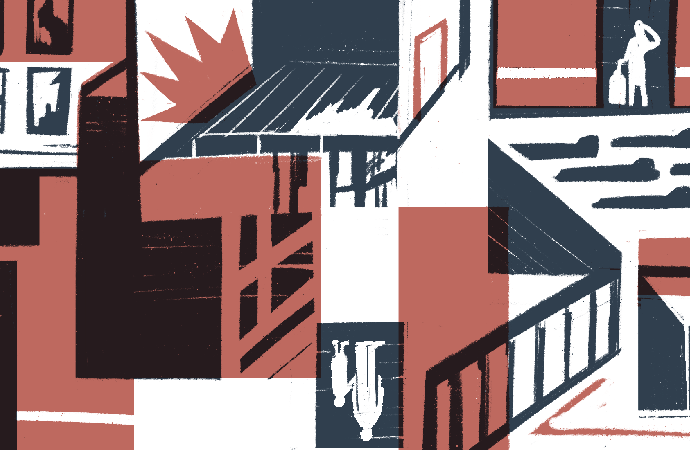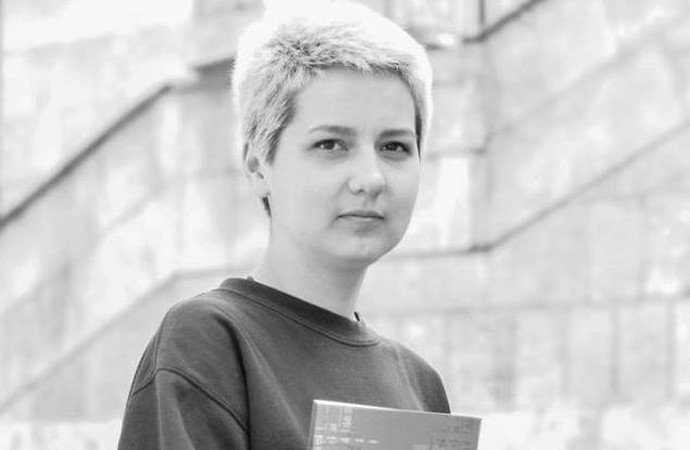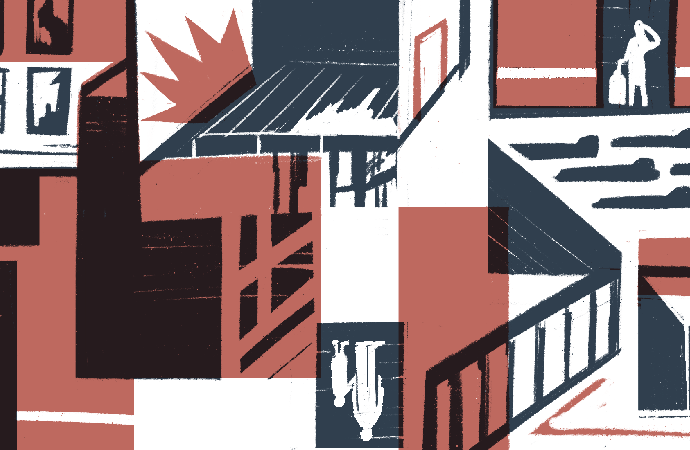
Cover by Kateryna Gritseva
LeftEast editors’ note: A version of this article was originally published in German on Laender Analysen, and in English on Spilne/Commons. We reprint this edited version in collaboration with ELMO – The Eastern European Left Media Outlet.
The full-scale Russian invasion of Ukraine caused an unprecedented housing crisis. More than hundred thousand homes have been destroyed or damaged, and millions of Ukrainians have had to flee. Ukrainian housing policy has not managed to adequately address the housing needs of internally displaced people (IDPs), though some civil society organizations and municipal urban administrations have created new non-profit forms of tenancy to aid IDPs. Yet, the situation in Ukraine still remains critical and necessitates a careful rethinking of the goals and mechanisms of housing policy in order to reshape the housing system in accordance with the new, wartime needs of Ukrainians.
The new housing crisis
The full-scale Russian invasion brought an unprecedented level of destruction and displacement. Conditions differ widely by family and individual. Some were able to return to their homes in Kyiv after the area was liberated, while others still cannot escape occupied Mariupol’ where their homes have been destroyed. Future Ukrainian housing policy will have to grapple with this diverse and changing situation on the ground. In this paper I offer the following classification system for displacement: 1. displacement caused by the dangers of war; 2. displacement caused by the destruction of homes; and 3. displacement caused by the rental market itself.
The first category of displaced people is by far the largest. The majority of displaced people in Ukraine left their homes to escape imminent danger to their life and health, an occupying regime, and the serious humanitarian crisis brought on by the invasion. In August 2022 the UN Refugee Agency estimated that there are 6,865,625 refugees from Ukraine in Europe and 6,645,000 IDPs in Ukraine. The majority of IDPs and refugees still have their homes and some are already coming back or planning to come back when the situation is safer, while some are willing to stay in the places they moved to.
Many, however, have no home to return to. This second category of displaced people are in a much more unstable situation, as their ability to get decent housing in the short term is far lower. According to Olena Shuliak, the Deputy Head of the Committee of the Verkhovna Rada, 15 million square meters of housing has been destroyed by the Russian army and nearly 800.000 Ukrainians have lost their homes due to the war. The most affected oblasts are Donetsk, Kharkiv, Kyiv, and Chernihiv. 220.000 people have already applied for compensation for destroyed housing. These people need to be temporarily housed while their homes are being rebuilt or repaired. Also, it is very probable that a significant number of them might not be willing to return to the place they used to live.
The third category of displaced people receives much less attention: tenants displaced due to the sky-rocketing prices in the rental market in the western regions of Ukraine. Transparency International states that between October 2021 and May 2022 the rents in the Lviv region increased by 96%, in the Uzhgorod region by 225%, and in Ivano-Frankivsk by 128%. Since then the price increases have calmed down slightly, but rent remains unaffordable not only for IDPs but also for locals. Landlords in these regions evicted many of their previous tenants in order to rent to IDPs from war torn regions who were willing to pay double the price, resulting in a highly speculative rental market. As the Ukrainian rental market is predominantly informal, there is no way to estimate the number of such evictions.
Housing before and during the war
Though accentuated sharply by the Russian invasion, the Ukrainian housing crisis has deep roots. During the Soviet period, housing in Ukraine was predominantly produced and redistributed by the state, though this redistribution was uneven and benefited the part of the working class that was deemed ‘useful’. Following the collapse of the Soviet Union and the transition to a market economy, Ukrainian housing policy has centered on homeownership as the main way of providing housing. This was done through: the mass privatization of housing in the 1990s; state support for the mortgage market in the 2000s; state support for private developers, especially through land-use policy; state subsidies to buy housing; a mass disinvestment in public housing; and the total absence of efficient regulations for the rental market.
With the Russian annexation of Crimea and the start of the war in the Donbas in 2014, around a million and a half of Ukrainians fled the occupied territories and territories along the front line. Finding housing for these IDPs suddenly became a key issue in Ukraine. Initial state efforts to provide housing during this crisis sought to aid displaced individuals in buying their own private flats. But such programs ended up providing only several hundred private flats a year. As a result, in 2020, after 6 years of war, approximately 70% of IDPs still had not found adequate housing. The goal of providing each family with a privately owned home proved impossible, even when the state channeled more funds into these programs. At the same time, the state provided social housing on an extremely low level (only around 1500 flats, the majority of which were in eastern Ukraine and are now lost). The rental market also remained unregulated, leaving IDPs on their own, many of whom faced discrimination from landlords both due to economic factors and to prejudice against people from Donbas.
This experience was repeated after the full-scale Russian invasion, though this time was far more catastrophic. In the first month, the Ukrainian state only managed to provide temporary housing for some IDPs. Most of this temporary housing is student dormitories and module housing. Such options are neither comfortable nor long-term. They need to be replaced with more sustainable housing, where you can have a home, not just a bed to sleep in and a roof above your head. Still the only long-term solution offered by the state is for IDPs to buy housing with low-rate mortgages. We have already seen how such programs didn’t work in the aftermath of 2014. The Ukrainian state still has made no effort to meet the actual needs of displaced people through regulation of the rental market, placing a hold on evictions, or providing any kind of non-profit housing. Since the full-scale invasion, the state’s main housing institution, the State Fund for Support of Youth Housing Construction, has bought only 52 flats for 6-7 million IDPs.
How have IDPs managed to survive?
In March and April of 2022 together with a group of colleagues I collected interviews with non-combatants, both people who had left their homes and arrived in western Ukraine and locals who had witnessed the mass influx of IDPs. This data reveals various ways in which people managed to house themselves and demonstrates how networks of civil society and local government have reacted to the crisis. It also points out the problems of profit-oriented housing policy in Ukraine.
The first practice applied by local authorities was to provide temporary housing. Temporary shelters were organized in municipal facilities such as schools and sporthalls. Due to the COVID-19 pandemic educational spaces were not in use, thus they became the public resource mobilized for temporary housing. The same process occurred in the private and civil sectors with the offices of companies and NGOs and cultural spaces being turned into shelters. These were predominantly self-organized efforts, however, much depended on infrastructural resources available before the escalation of the war. Municipalities managed to provide the infrastructure, but the management of displaced people was done by volunteers. Ultimately much of this temporary housing ended up becoming long-term, as greedy landlords in Western Ukraine set exorbitant rates for rent that few IDPs could meet.
Also the absence of social housing programs and social housing units contributed to the growing housing crisis, the only exception being a few uncoordinated decisions by regional, urban, or university authorities to use available housing as non-profit housing. In some places, like Vinnytsia, municipal institutions have been set up to negotiate between IDPs and landlords, limiting rental speculation, evictions, and discrimination against renters. Such policies are emergency crisis measures, but they could potentially become the basis for socially-oriented housing policy. However, the chances of putting such policies into practice on a mass scale is very low, as Ukrainian state housing policy remains oriented towards subsidizing private homeownership. Current state programs for displaced people are intended to invest both in the supply and the demand side of the housing development, an approach which, aside from being completely ineffective, supports the developers, not the people.
The Ukrainian state and international partners’ plans for ‘Rebuilding Ukraine’
As a response to the massive destruction of housing and infrastructure, the Ukrainian government is designing the so-called ‘Rebuilding Ukraine’ plan, of which housing policy is a key component.On the international level, the financing of the ‘Rebuilding’ will affect not only the housing sector but the structure of the Ukrainian economy for the following years or even decades. At the moment, Ukraine expects inflow of liquidity from international financial institutions, such as the IMF, from partner states, and from reparations in the form of confiscated Russian assets in the West. Such aid is being planned in the form of grants and credits. While Ukrainian foreign debt is not being restructured, these credits will deepen the Ukrainian economy’s dependence on foreign financial institutions, making investment in non-profit housing more difficult. On the national level, the internal distribution of this foreign aid will only perpetuate the existing housing policy that supports homeownership and ignores non-profit housing.
What kind of housing policy does Ukraine need?
Housing or any other kind of social policy should be based on people’s needs. Huge numbers of Ukrainians have had to flee. For many this displacement is temporary, for others long-term, and for some it will become permanent. Some have no home to return to. Even some of those who didn’t have to flee have been evicted because of the skyrocketing rent market. Ukrainian IDPs’ futures depend not only on the development of war, but also the possibilities of employment, old and new social contacts, and a feeling of belonging in one’s home that may be broken. That’s why the housing sector should be more diverse, so it can adjust to various and changing needs.
Effective regulation of the rental market and the creation of decent, non-profit housing has the capacity to help solve not only the housing crisis caused by war and benefit post-war recovery, but also save lives during the war and even help Ukraine to win. Here the history of housing policy during and after the First and Second World Wars can offer solutions in the present..
The regulation of the rental market became widespread during WWI, when militaries, refugees, and many other social groups were in great need of social support. Following the example of France, most European countries, their colonies, the Russian Empire, and certain regions of the US placed a moratorium on rent and evictions from 1914 till 1920. Such policies helped displaced people find housing in safe regions and stay there, while at the same time providing militaries with housing near the front. WWII brought on a much larger wave of social housing policy in Europe. This type of policy helped poor people, refugees, and the families of the military not to end up on the streets or in the line of fire.
After almost a year since the full-scale invasion of Ukraine by Russia, the limited attempts by several municipal officials to regulate the rental market in certain Ukrainian cities has not led to any palpable results due to lack of support from the national government, especially from the MinRegion, which is responsible for housing policy. Most Ukrainian IDPs still live in uncomfortable, temporary shelters or have had to return to cities still suffering from Russian shelling.
The development of a non-profit rental sector can already right now make housing more affordable and provide housing to those who need it most much faster than the process of rebuilding and compensation currently being proposed by the Ukrainian government. This non-profit housing could be organized by municipalities and state companies as much as through private developers, ensuring that a portion of the housing stock is collectively owned.
The Russian invasion in February has caused a housing crisis that is spiraling out of control, though housing activists have been strengthening their efforts and a grassroots movement to create affordable housing is growing. These activists seek to regulate the rental market and implement both social and cooperative housing. For example, housing activists from Lviv demand the concession of vacant buildings for the use as temporary housing for IDPs. A collective of IDPs has been working since the start of the war to build cooperative housing themselves. Such initiatives involve networking, the sharing of experience, involve local government, and make demands on the national government.
In such an apocalyptic times Ukrainian society has a chance to fight and obtain the right for decent housing. The voices of Ukrainians demanding such rights must be included in the rebuilding process to ensure decent living conditions in the decades that will follow the war.
For the millions of IDPs and Ukrainians simply facing rampant housing insecurity, this crisis offers an opportunity to reform the Ukrainian housing sector around the needs of the people, not the developers and landlords.

Alona Liasheva is a sociologist, researcher of urban political economy, works at The Research Centre for East European Studies at the University of Bremen and at the Taras Shevchenko National University of Kyiv

